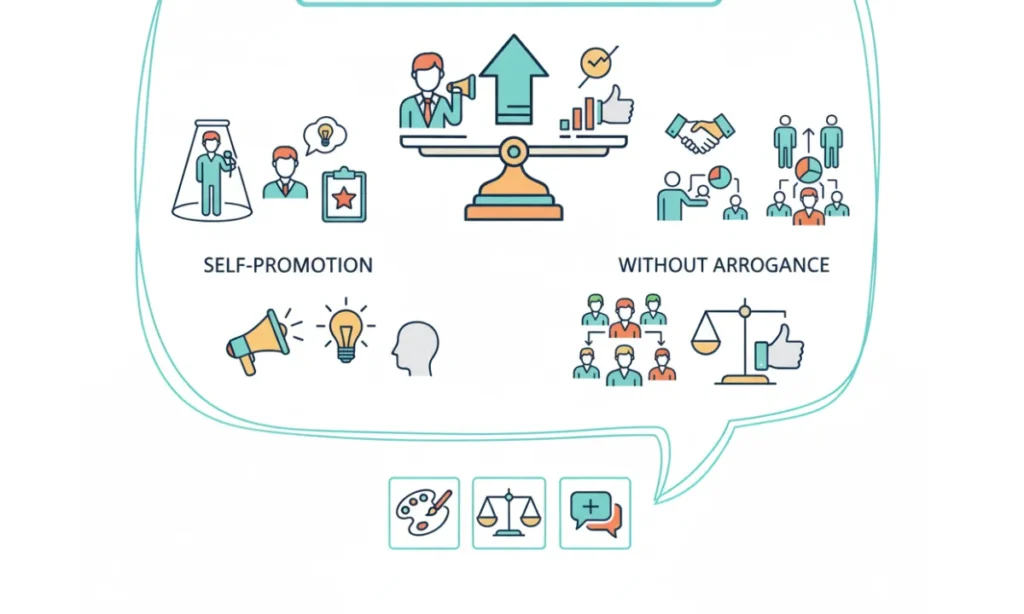Most professionals feel awkward with self-promotion. The fear of being boastful or arrogant does not allow talented persons to defend themselves, which restricts their professional opportunities and career growth. However, in competitive working conditions, individuals who are able to communicate their worth always perform better than similarly skilled people who do not speak out concerning their contributions.
It is a problem to strike the right balance between self-advocacy with confidence and sincere humility. Good self-promotion does not need to be about overstating the achievements and undermining those of others. It is all about effectively and honestly conveying your value in a manner that fosters relationships, professionalism and provides a chance of progress.
This ability is especially essential in times of transition of leadership, where credibility and trust building needs to demonstrate competence with respect to team dynamics. The most effective professionals know how to use techniques that are subtle, but strong enough to emphasize the strong points without making the colleagues and supervisors feel negatively about them.
Understanding the Difference Between Confidence and Arrogance
The boundary between self-promotion and arrogance is thin and sometimes it is difficult to distinguish between these two, nevertheless, there are certain distinctive features that distinguish them. Self assured professionals are fact oriented, consider input of the team, and put their success into the context of overall organizational success. Prideful people inflate priorities, downplay the contributions of other people and place themselves as being indispensable.
Confidence is expressed in certain instances and quantifiable outcomes instead of unquantifiable allegations of being the best or indispensable. In the context of the answer on the success, confident professionals present some background on the obstacles that were overcome, resources that were used, and cooperation that was necessary. This style is competent and is aware of the things that led to success.
Arrogance is usually associated with superlatives and comparisons, which put others down. Such expressions as I am the only one who can deal with this or without me this project would have failed are the first indications of problematic attitudes that ruin relationships and credibility.
The best self promotion recognizes the uncertainty and growth areas in addition to achievements. Experienced employees talk about things they learned during their failures, aspects they are working on, and how their colleagues have helped them. This moderate view instills confidence and shows self-knowledge which is recognized in leadership.
Strategic Timing for Self-Advocacy

Self-promotion would work best when it is in the context of natural chances and not imposed on its unsuitable situations. Organic openings to talk about the contributions and achievements are opportunities presented by performance reviews, project completions, team meetings, and informal conversation with supervisors.
When it comes to performance reviews, make sure you have certain examples that show how you can influence the targets of the team and company goals. Measure outcomes where feasible, but emphasize the process and teamwork of doing so as opposed to taking credit. This strategy demonstrates the level of strategic thinking and team awareness as well as articulating the value.
The project wrap-up meetings are also a good chance to showcase your work and recognition of the team work. Talk about obstacles you overcame, new strategies you employed, and lessons that you learned in order to apply to new projects. This makes you a considerate employee who brings value in addition to the performance of simple tasks.
Frequent individual meetings with supervisors give a consistent chance at doing subtle self-promotion by constantly updating on progress and discussing solutions to problems. Post barriers you have overcome, changes you have made and things you are working on. Such regular communication makes your contributions noticeable and does not need foaming at the mouth announcements.
Do not promote yourself at the time when others are being recognized, at the time of crisis or at the time when your co-workers are facing difficulties. These situations render self-advocacy tone-deaf and harm relationships that may contribute to long-term career success.
Framing Achievements as Team Successes
The most advanced manner of self promotion is the ability to mention personal input and focus on shared success. This is the best way of establishing relationships without losing your position that is appreciated by major stakeholders.
Talking about the project results, begin with recognizing the team work before explaining your particular efforts. As an example: our team met and even surpassed the quarterly goals through the effort of everybody. I concentrated on simplifying the approval process that made the cycle time 30 percent shorter and helped us to accept more client work.
Use we language when reporting about the general success and then switch to I statements when reporting about your role specifically. This structure indicates team orientation and at the same time does not have your contributions lost in group accomplishments. It also shows the leadership mentality that is appreciated in terms of promotion.
Give out share freely and precise on your participation. Instead of calling the whole project a real success, show the value that you created that was unique: creative methods, networking, problem solving, process enhancements that were a part of the positive results.
This framing is especially significant when the change in leadership is concerned, and the process of establishing credibility will involve the ability to show not only competence but also collaborative qualities. New leaders who successfully demonstrate their skills without undermining the team processes build trust faster and support their initiatives.
Using Data and Specifics Over Generalizations
Plausible self-promotion is based on concrete evidence that does not make oneself sound boastful or exaggerated. Measures of specifics, specific deadlines, and specific examples produce powerful stories that prove value and not based on subjective statements.
Instead of such general statements as I am great with clients, you need to provide specific examples: I have had a 95% client retention rate in 18 months and have also gained three contract renewals and earned an extra $2.4 million in revenue. This will allow the facts to speak it all and give the context that the supervisors can easily comprehend and recall.
Measure things where possible, and avoid the pretence to accuracy where none are. Guest figures can be more effective than precise figures that can be doubted. I saved about 25-30 percent of processing time” would be more believable than that it was 27.3 percent better with no documentation to support it.
Record accomplishments when they happen and not attempting to recollect the information after a few months when it comes to performance reviews. Record in some simple way the project outcomes, positive feedback, problems resolved, and efforts initiated. This planning allows one to promotes himself with a lot of confidence and specificity in case of opportunities.
Pay attention to the effect on business and not mere completion of activities. Talking about how your work contributed to revenue, efficiency, customer satisfaction, or team performance is evidence of strategic thinking and results orientation that the leaders consider when making decisions to advance.
Building Your Personal Brand Through Consistency
Self-promotion is not a one-time activity but a regular practice of professionalism that helps you to cement your image and value offer. Your individual brand is built by trusted performance of your main strengths and providing high-quality work on a regular basis.
Identify two or three competencies that distinguish you among your peers and always find ways of practicing those strong points. It may be problem-solving, relationship-building, or creative thinking but by presenting the skills on a consistent basis, the skills become known, they do not need to be advertised by self-identification.
Volunteer in visible projects, which match your career goals and strengths. Natural opportunities to demonstrate abilities are offered to strategic project selection and make a contribution to the success of the organization. This is done to generate good publicity without creating the perception of an egoistical mannerism.
Sharing of ideas and knowledge by using the right medium such as team meetings, making internal presentation or having a casual talk with a colleague. Considerable contributions to organizational knowledge are valuable as well as developing your reputation as a subject matter expert in pertinent fields.
Always uphold high standards of quality that support your career image. Trust and credibility that is earned through reliable excellence in every work product can be used to explicitly promote oneself when the right time comes. When there is a rise in promotion, people recollect consistent performers.
Leveraging Feedback and Recognition
Turn feedback and other people into effective self-promotional instruments that are more credible than self-promotions. Third-party validation is a very objective way of demonstrating your worth without making it look boastful.
When you are getting positive feedback, request to share it with the concerned stakeholders or provide it in performance documentation. The statements of client compliments, peer recognition and supervisor praise are persuasive pieces of evidence of your impact when they are shared in the right way.
Ask colleagues and supervisors to provide specific feedback to team success regarding your efforts. Their answers give you words and illustrations that you should employ in your self-promotion talks in the future. This strategy also shows continuous improvement attitude that leaders appreciate.
Conduct follow ups on the successful projects by querying the stakeholders as to the effects and value they received. Their reactions present tangible results of your efforts as building relationships that will help in the future and referrals.
Give recognition as the basis of discussing enlarged duties or fresh challenges. When you are recognized to have performed well, show appreciation and at the same time show interest in undertaking more projects that can make use of your strengths.
Navigating Self-Promotion in Different Contexts
The strategies of self-promotion should be able to suit different professional situations, relationships and organizational cultures. What could be effective in less formal team building situations may not be effective in formal presentation and what works well with fellow team members may not be the right style when addressing the top leadership.
In the case of supervisors, it is business impact and alignment with the organizational goals. Contextualize your contributions based on their contribution to the team objectives, department objectives or the company strategy. This is a strategic way to think and also to bring out the best in you.
With your colleagues, you should focus on teamwork and shared success without making your input to be understated. Give out share liberally and be particular about your contribution to the good results. This balance keeps the relationships and develops recognition.
In the presentations that you make to the top management, focus on the outcomes and the strategic implications as opposed to the process descriptions. The executive audiences desire to know about impact and possibility as opposed to implementation details. Write brief outlines of what you have done best.
In the text messages such as emails or reports, be specific, and factual in language that records what you have done but does not make you sound boastful. Allow success to be the best judge of itself by particular instances and quantifiable results instead of opinions.
Making Self-Promotion a Natural Part of Professional Communication
This kind of self-promotion is most effective when it becomes embedded within the normal professional interaction as opposed to being imposed or unnaturally endowed. This involves getting comfortable talking about what you have done as easily as you may communicate project progress or industry news.
Rehearse to say your value proposition in many different ways: elevator pitches, summaries of performance reviews, project updates, and informal conversations. Practice develops confidence and enables one to find the most interesting ways of expressing your strengths and achievements.
Make several illustrations of what you are able to do. The presence of a prepared set of particular stories will avoid the clumsy scramble that follows when one realizes that there is an opportunity to promote themselves and is in an unfortunate situation to be caught off guard during a meeting or conversation.
Get on the improvement and future promise instead of thinking about the past success. Along with the points on past achievements, also explain what has been learned, what skills are being developed, and what is planned to be done on future projects. This progressive mindset and planning is reflected in this forward-thinking.
It is important to remember that good self-promotion is not only in the interest of the organization but also in the interest of self-promotion. Once your superiors are aware of your potentials, they are able to make more informed choices regarding project placement and team building, as well as other development opportunities that meet the interests of all parties.
Transforming Self-Advocacy into Career Advancement
Learning to promote oneself without being arrogant has compound returns that are way beyond the immediate appreciation. When professionals effectively communicate their value, they are able to establish better relationships, access superior opportunities and have the confidence to be leaders.
Begin with these strategies in small steps, with one or two techniques that seem to be the most natural and suitable in your present circumstances. With growth of comfort and proficiency, broaden your scope to incorporate other techniques that will demonstrate other facets of your professional worth.
Observe the reaction you get to change your style according to what you are getting the best response out of with your colleagues and supervisors. Self-promotion needs to be continuously honed depending on the responses and outcomes and not strictly followed by pre-written scripts.
It is not to be in a position to be what you are not, but to make sure that whatever value you have as yourself is given the appreciation it rightly deserves. Self-promotion is a logical continuation of professional communication and with practice and strategic thinking, it is a process that allows one to grow faster in his or her career, and at the same time, the relationships that have been built to achieve success in the long-term are not compromised.








